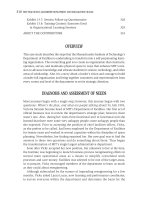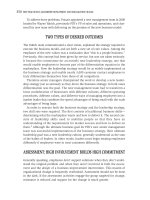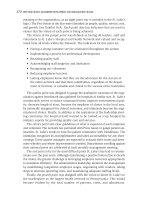Tài liệu Best Practives in Leadership Development & Organization Change 40 doc
Bạn đang xem bản rút gọn của tài liệu. Xem và tải ngay bản đầy đủ của tài liệu tại đây (161.06 KB, 10 trang )
360
BEST PRACTICES IN LEADERSHIP DEVELOPMENT AND ORGANIZATION CHANGE
customer who participated in the customer focus conferences has inquired how
they might run a conference for their own customers. And the PDI distributor
network has expressed similar interest.
Although it is difficult to quantify the impact, improving business results
are clearly related to employee and managerial actions. Sales are running
below planned growth, due to the recession in the North American manufac-
turing economy. But operating profit is on or close to plan. Employees are show-
ing evidence of understanding the business realities and are committed to doing
their part to control costs, reduce customer turnover, and win new business.
Going forward, PDI will monitor progress through a variety of measures:
Future Measures for Monitoring Success
• Tracking progress against the baseline data gathered at the beginning of
implementation
• Monitoring employee survey results
• Tracking the adoption of new customer contact behaviors via customer
scorecards
• Following the turnover rate among employees, which is expected to
drop as a result of changed management practices
• Monitoring the rate of customer churn, which is expected to slow as
new customer contact behaviors build stronger ties to customers
• Measuring the new customer win rate, also expected to improve as new
product and service offerings, coupled with differentiating actions and
attitudes, create a more compelling offering
LESSONS RELEARNED
Someone once observed that “experience is recognizing the same mistake when
you make it again.” PDI’s experience with large-scale change has proven again
some familiar truths for managing change. What is noteworthy about PDI’s change
initiative is how it is engaging its people as a source of sustainable competitive
advantage. Market advantage gained through technology, product functionality,
geographic presence, or financial positioning is easily matched by competitors in
ever-decreasing cycle times. The one competitive advantage that is difficult to
duplicate is that gained through people. Wayne Yakich and his team of senior man-
agers realized that the packaged gas business is a people business. In order to turn
around a stalled strategic rollup plan, he needed the commitment of all 750 man-
agers and 3500+ employees at 435 locations. Rather than making the same mis-
take as his predecessors, Yakich opted for a different approach. He knew that a
business strategy based on different products and services, while desirable, could
cart_14399_ch15.qxd 10/19/04 1:17 PM Page 360
PRAXAIR
361
eventually be duplicated, but that a leadership strategy that differentiated employ-
ees could complement the business strategy and quite possibly add a sustainable
advantage that would translate into market leadership.
NOTES
1. Kocourek, Paul F., Chung, Steven Y., and McKenna, Matthew G. Strategic Rollups:
Overhauling the Multi-Merger Machine (Strategy Publication Issue 19). New York:
Booz Allen Hamilton. Available at />export.php?article_id=16858
2. See “Executive vs. Leaders: Is There a Difference,” Rich Rardin, Manchester
Review, Spring/Summer, 1999.
3. Four-step leadership strategy design tool. Step 1: Identify those customer contact
behaviors that would truly differentiate PDI employees from all others suppliers.
Step 2: Identify current and desired leadership philosophy within PDI using the
leadership philosophy map. Step 3: Make explicit the new leadership values that
are implicit in the desired leadership philosophy. Step 4: Redesign current man-
agement practices to reflect the new leadership values. These management prac-
tices, when implemented, will give substance to the new values, which in turn
will reflect the new leadership philosophy, which when followed will reinforce the
new customer contact behaviors.
4. PDI’s leadership philosophy map reflects the current leadership philosophy among
managers as well as their desired one (see Exhibit 15.2). The definitions to each
of the four parts follow:
Mental Model—the culturally accepted understanding of the leader’s role
Motive—the driving force behind the leader’s actions
Manner—the way in which employees are treated
Methods—the overall characterization of the processes or procedures leaders use
5. Leadership culture assessment model and tool adapted from Roger Harrison and
Herb Stokes, Diagnosing Organizational Culture (San Francisco: Jossey-Bass, 1992).
6. Process steps for conducting customer focus conferences:
Preconference
• Launch employee participant nomination process: three to four people from
each of four to five customer contact groups
• Invite local customers to participate
• Prepare local meeting space and related logistics
Conference Design
• Welcome, introductions, and ground rules
• Customer presentations
cart_14399_ch15.qxd 10/19/04 1:17 PM Page 361
362
BEST PRACTICES IN LEADERSHIP DEVELOPMENT AND ORGANIZATION CHANGE
• Employee small groups to review their own customer contact behaviors; prepare
presentation to customers
• Dialogue between customers and employees; employees revisit attitudes and
actions and recommend five each
• Lunch
• Employee small groups discuss and report barriers to being more customer
focused
• Employees report actions needed from managers to enhance customer focus
• Employees report on ways to train colleagues in new attitudes and actions and
on how to monitor successful implementation
Postconference
• Explain conference outcomes to all employees
• Design training on new customer contact behaviors
• Budget and conduct training
• Create and begin using customer scorecards for feedback on effectiveness
Exhibit 15.2. PDI’s Leadership Philosophy Map
Past: Get results,
no excuses
Desired: Get results
through motivated
people
Past: Expendable assets
Desired: Trusted partners
Past: Self-preservation
Desired: Help others
succeed
Past: Controlling and
inconsistent
Desired: Consistent and
growth-oriented
Leadership
Motive
Methods
Mental
model
Manner
cart_14399_ch15.qxd 10/19/04 1:17 PM Page 362
PRAXAIR
363
7. Here’s a sample of attitudes and actions for one role group, counter sales:
Counter Sales: Attitudes and Actions
• Attitude: safety first
Demonstrates a safety-first attitude
Advises customers on safe handling of products
Helps load product safely into customer’s vehicle
The store is free from tripping and other safety hazards
• Attitude: “can-do” problem solver
Displays and uses flyers, Solution Guides, and other resources
Probes, listens, understands customer needs, and offers best solution
Demonstrates knowledge of our products and business
Answers questions and explains related products and services
Someone from Praxair has called to see whether all is well after I have made a
significant purchase (for example, a welding machine)
• Attitude: responsive and reliable
Provides accurate and reliable information
Fills orders quickly and accurately
Returns phone calls promptly
Follows up on orders
Stocks items I frequently use
• Attitude: honesty
Tells the truth, does not hide mistakes
Finds out correct answers when not sure
Keeps commitments to get back to customers
• Attitude: professional and positive
Acknowledges customer even when tied up with someone else
Greets customer by name, smiles, makes eye contact
Comes out from behind the counter, shakes hands, and gives name
Treats all customers as though it was their first visit
Keeps store clean and appealing
Helps customers take product to vehicle
Takes pride in personal appearance
• Attitude: team player
I get high-quality service at all Praxair stores
Offers to share technical expertise
Draws on other Praxair resources to solve my problem
cart_14399_ch15.qxd 10/19/04 1:17 PM Page 363
364
BEST PRACTICES IN LEADERSHIP DEVELOPMENT AND ORGANIZATION CHANGE
ABOUT THE CONTRIBUTORS
John Graboski is director, human resources, at Praxair Distribution, Inc. He has
worked in the corporate world for twenty-five years, in marketing and sales, as
well as HR, in three very different industries (telecommunications, health care
insurance, and industrial gases). Still a marketing guy at heart, he looks at his
role as one of helping employees sell not only the company’s products but also
themselves successfully to customers. He lives with his wife, Ginny, and two
teenage daughters, Caitlin and Lexi, in Cheshire, Connecticut.
Ruth Neil is manager, training and development, at Praxair Distribution, Inc.
She has a thirty-four-year track record in organizational change initiatives, espe-
cially through training and development, employee relations, and employee
communications interventions. Her focus has been on grassroots implementa-
tion of strategic change leading to service excellence in organizations and to
increased employee competence and commitment.
Rich Rardin is president of BenchStrength Development, LLC. He helps orga-
nizations develop leadership strategies that align with and drive their business
strategies in order to achieve marketplace objectives. A skilled facilitator, Rich
empowers teams, as well as individual executive leaders, to overcome barriers
to organizational change objectives while living out their core values. He has
worked in leadership and organization development with a variety of Fortune
500 and nonprofit companies for over twenty-five years. He has presented his
proprietary executive coaching model at human resource conferences world-
wide. Rich and his family reside in Newtown, Connecticut.
cart_14399_ch15.qxd 10/19/04 1:17 PM Page 364









